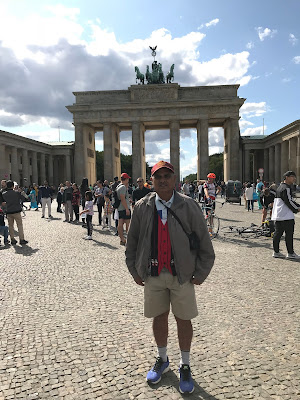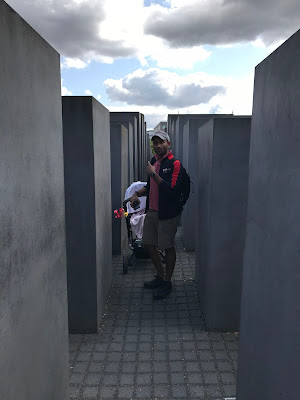
CHAPPIDI ABHIRATH REDDY,g
C/O COL GKS REDDY,
Secunderabad - 500 087.
Visited Berlin from 25 Aug to 28 Aug 2018 along with my Younger Daughter and family. Took off from Stansted Airport, London at 0800h on 25 Aug and landed in Berlin at about 1000h. And returned to Stansted on 28 Aug (AN).
Germany
Germany (German: Deutschland German pronunciation: [ˈdɔʏtʃlant]), officially the Federal Republic of Germany (German: Bundesrepublik Deutschland,  listen (help·info)), is a country in central-western Europe. It includes 16 constituent states, covers an area of 357,386 square kilometres (137,988 sq mi), and has a largely temperate seasonal climate. With nearly 83 million inhabitants, Germany is the most populous member state of the European Union. Germany's capital and largest metropolis is Berlin, while its largest conurbation is the Ruhr, with its main centres of Dortmund and Essen. The country's other major cities are Hamburg, Munich, Cologne, Frankfurt, Stuttgart, Düsseldorf, Leipzig, Bremen, Dresden, Hannover, and Nuremberg.
listen (help·info)), is a country in central-western Europe. It includes 16 constituent states, covers an area of 357,386 square kilometres (137,988 sq mi), and has a largely temperate seasonal climate. With nearly 83 million inhabitants, Germany is the most populous member state of the European Union. Germany's capital and largest metropolis is Berlin, while its largest conurbation is the Ruhr, with its main centres of Dortmund and Essen. The country's other major cities are Hamburg, Munich, Cologne, Frankfurt, Stuttgart, Düsseldorf, Leipzig, Bremen, Dresden, Hannover, and Nuremberg.
Berlin
Berlin (/bɜːrˈlɪn/; German pronunciation: [bɛɐ̯ˈliːn]) is the capital and largest city of Germany by both area and population. Its 3,711,930 (2017) inhabitants make it the second most populous city proper of the European Union after London. The city is one of Germany's 16 federal states, and it is surrounded by the state of Brandenburg, the capital of which, Potsdam, is contiguous with Berlin. The two cities are at the center of the Berlin/Brandenburg Metropolitan Region, which is, with 6,004,857 (2015) inhabitants, Germany's third-largest metropolitan region after the Rhine-Ruhr and Rhine-Main regions.
Berlin straddles the banks of the River Spree, which flows into the River Havel (a tributary of the River Elbe) in the western borough of Spandau. Among the city's main topographical features are the many lakes in the western and southeastern boroughs, formed by the Spree, Havel, and Dahme rivers, the largest of which is Lake Müggelsee. Due to its location in the European Plain, Berlin is influenced by a temperate seasonal climate. About one-third of the city's area is composed of forests, parks, gardens, rivers, canals and lakes. The city lies in the Central German dialect area, the Berlin dialect being a variant of the Lusatian-New Marchian dialects.
The Brandenburg Gate, Berlin
The Brandenburg Gate (German: Brandenburger Tor; [ˈbʁandn̩bʊɐ̯gɐ ˈtoːɐ̯]) is an 18th-century neoclassical monument in Berlin, built on the orders of Prussian king Frederick William II after the (temporarily) successful restoration of order during the early Batavian Revolution.[1] One of the best-known landmarks of Germany, it was built on the site of a former city gate that marked the start of the road from Berlin to the town of Brandenburg an der Havel, which used to be capital of the Margraviate of Brandenburg.
It is located in the western part of the city centre of Berlin within Mitte, at the junction of Unter den Linden and Ebertstraße, immediately west of the Pariser Platz. One block to the north stands the Reichstag building, which houses the German parliament (Bundestag). The gate is the monumental entry to Unter den Linden, the renowned boulevard of linden trees, which led directly to the royal City Palace of the Prussian monarchs.
Throughout its existence, the Brandenburg Gate was often a site for major historical events and is today considered not only as a symbol of the tumultuous history of Europe and Germany, but also of European unity and peace.
Brandenburg Gate Berlin
A closeup view of Brandenburg Gate Germany
Another view of the Gate
A closer view of the Gate
A view of the Gate from Brandenburg side
A closer view of the Gate from the Brandenburg Side
A closeup of the Right wing of the Gate,
taken by my son-in-law
A side view of the Brandenburg Gate with Bundstag in the Background
The Bundestag, Berlin
The Bundestag (German pronunciation: [ˈbʊndəstaːk], "Federal Diet") is the German federal parliament. It can be compared to the lower house of parliament along the lines of the United States House of Representatives, the Irish Dáil Éireann or the House of Commons of the United Kingdom, with the Bundesrat, though a separate institution, having a similar role to the upper house of a bicameral parliament.
The Bundestag was established by chapter III of the Basic Law for the Federal Republic of Germany[1] (Constitution) in 1949 as one of the legislative bodies of Germany and thus the historical successor to the earlier Reichstag.
Since 1999 it has met in the Reichstag Building in Berlin. Wolfgang Schäuble is the current President of the Bundestag. Members of the Bundestag (Mitglieder des Bundestages) are usually elected every four years by all adult German citizens in a mixed system of constituency voting and list voting. The constitutional minimum number of seats is 598; with overhang and leveling seats there are currently 709 seats. The Election Day can be called earlier than four years after the last if the Federal Chancellor (Bundeskanzler) loses a vote of confidence and asks the Federal President (Bundespräsident) to dissolve the Bundestag in order to hold new general elections.
A view of the Bundestag from the Brandenburg Gate
A closer view of Bundestag from Brandenburg Gate Side
Another View of the Bundestag from the Gate Side
A Frontal view of Bundestag
Another view of Bundestag
A long shot of Frontal view of Bundestag
The Victory Column, Berlin
The Victory Column (German:  Siegessäule (help·info), from Sieg ‘victory’ + Säule ‘column’) is a monument in Berlin, Germany. Designed by Heinrich Strack, after 1864 to commemorate the Prussian victory in the Danish-Prussian War, by the time it was inaugurated on 2 September 1873, Prussia had also defeated Austria and its German allies in the Austro-Prussian War (1866) and France in the Franco-Prussian War (1870–71), giving the statue a new purpose. Different from the original plans, these later victories in the so-called unification wars inspired the addition of the bronze sculpture of Victoria, 8.3 metres (27 ft) high and weighing 35 tonnes, designed by Friedrich Drake. Berliners have given the statue the nickname Goldelse, meaning something like "Golden Lizzy".
Siegessäule (help·info), from Sieg ‘victory’ + Säule ‘column’) is a monument in Berlin, Germany. Designed by Heinrich Strack, after 1864 to commemorate the Prussian victory in the Danish-Prussian War, by the time it was inaugurated on 2 September 1873, Prussia had also defeated Austria and its German allies in the Austro-Prussian War (1866) and France in the Franco-Prussian War (1870–71), giving the statue a new purpose. Different from the original plans, these later victories in the so-called unification wars inspired the addition of the bronze sculpture of Victoria, 8.3 metres (27 ft) high and weighing 35 tonnes, designed by Friedrich Drake. Berliners have given the statue the nickname Goldelse, meaning something like "Golden Lizzy".
The Victory Column is a major tourist attraction in the city of Berlin. Its viewing platform, for which a ticket is required, offers a view over Berlin.
A view of the Victory column Berlin
A long shot of the Victory Column
A view of the park opposite the Victory Column
The Holocaust Memorial, Berlin
The Memorial to the Murdered Jews of Europe (German: Denkmal für die ermordeten Juden Europas), also known as the Holocaust Memorial (German: Holocaust-Mahnmal), is a memorial in Berlin to the Jewish victims of the Holocaust, designed by architect Peter Eisenman and engineer Buro Happold. It consists of a 19,000-square-metre (200,000 sq ft) site covered with 2,711 concrete slabs or "stelae", arranged in a grid pattern on a sloping field. The stelae are 2.38 metres (7 ft 10 in) long, 0.95 metres (3 ft 1 in) wide and vary in height from 0.2 to 4.7 metres (7.9 in to 15 ft 5.0 in).[2] They are organized in rows, 54 of them going north–south, and 87 heading east–west at right angles but set slightly askew. An attached underground "Place of Information" (German: Ort der Information) holds the names of approximately 3 million Jewish Holocaust victims, obtained from the Israeli museum Yad Vashem.
Building began on April 1, 2003, and was finished on December 15, 2004. It was inaugurated on May 10, 2005, sixty years after the end of World War II, and opened to the public two days later. It is located one block south of the Brandenburg Gate, in the Mitte neighborhood. The cost of construction was approximately €25 million.
A view of the Holocaust Memorial
Inside the Memorial
Another view of the Memorial
At Holocaust Memorial
The Holocaust Memorial
Holocaust Memorial Berlin
A view of US Embassy, Berlin located adjacent to the Memorial























